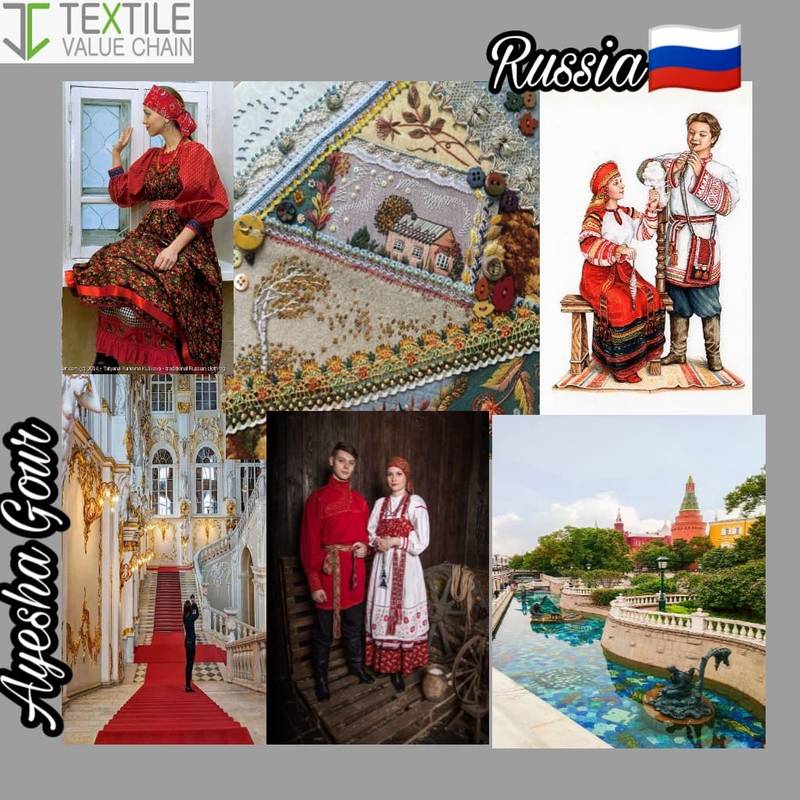Russia is a transcontinental country located in Eastern Europe and Asia. Covering an area of 17,125,200 square kilometers it is the largest country in the world by area, spanning more than one-eighth of the Earth’s inhabited land area, stretching eleven time zones, and bordering 16 sovereign nations. The territory of Russia extends from the Baltic Sea in the west to the Pacific Ocean in the east, and from the Arctic Ocean in the north to the Black Sea and the Caucasus in the south. With 146.7 million inhabitants living in the country’s 85 federal subjects,[9] Russia is the most populous nation in Europe and the ninth-most populous nation in the world. Russia’s capital and largest city is Moscow; other major urban areas include Saint Petersburg, Novosibirsk, Yekaterinburg, Nizhny Novgorod, Kazan and Chelyabinsk.
The Russian economy ranks as the fifth-largest in Europe, the eleventh-largest in the world by nominal GDP and the fifth-largest by PPP Russia’s extensive mineral and energy resources are the largest such reserves in the world making it one of the leading producers of oil and natural gas globally The country is one of the five recognized nuclear weapons states and possesses the largest stockpile of nuclear warheads Russia is a major great power, as well as a regional power, and has been characterized as a potential superpower. The Russian Armed Forces have been ranked as the world’s second most powerful, and the most powerful in Europe. Russia hosts the world’s ninth-greatest number of UNESCO World Heritage Sites, at 29 and is among the world’s most popular tourist destinations It is a permanent member of the United Nations Security Council and an active global partner of ASEAN, as well as a member of the Shanghai Cooperation Organisation (SCO), the G20, the Council of Europe, the Asia-Pacific Economic Cooperation (APEC), the Organization for Security and Co-operation in Europe (OSCE), the International Investment Bank (IIB) and the World Trade Organization (WTO), as well as being the leading member of the Commonwealth of Independent States (CIS), the Collective Security Treaty Organization (CSTO) and a member of the Eurasian Economic Union (EAEU).
Culture of Russia:. Customs and traditions of Russia
There are over 160 different ethnic groups and indigenous peoples in Russia. The country’s vast cultural diversity spans ethnic Russians with their Slavic Orthodox traditions, Tatars and Bashkirs with their Turkic Muslim culture, Buddhist nomadic Buryats and Kalmyks, Shamanistic peoples of the Extreme North and Siberia, highlanders of the Northern Caucasus, and Finno-Ugric peoples
Handicraft
Handicraft, like Dymkovo toy, khokhloma, gzhel and palekh miniature represent an important aspect of Russian folk culture. Ethnic Russian clothes include kaftan, kosovorotka and ushanka formen, sarafan and kokoshnik for women, with lapti and valenki as common shoes. The clothes of Cossacks from Southern Russia include burka and papaha, which they share with the peoples of the Northern Caucasus.


Russia Cuisines
Russian cuisine widely uses fish, caviar, poultry, mushrooms, berries, and honey. Crops of rye, wheat, barley, and millet provide the ingredients for various breads, pancakes and cereals, as well as for kvass, beer and vodka drinks. Black bread is rather popular in Russia, compared to the rest of the world. Flavourful soups and stews include shchi, borsch, ukha, solyanka and okroshka. Smetana (a heavy sour cream) is often added to soups and salads. Pirozhki, blini and syrniki are native types of pancakes. Chicken Kiev, pelmeni and shashlyk are popular meat dishes, the last two being of Tatar and Caucasus origin respectively. Other meat dishes include stuffed cabbage rolls (golubtsy) usually filled with meat Salads include Olivier salad, vinegret and dressed herring.


Architecture
Since the Christianization of Kievan Rus’ for several ages Russian architecture was influenced predominantly by the Byzantine architecture. Apart from fortifications (kremlins), the main stone buildings of ancient Rus’ were Orthodox churches with their many domes, often gilded or brightly painted.
Aristotle Fioravanti and other Italian architects brought Renaissance trends into Russia since the late 15th century, while the 16th century saw the development of unique tent-like churches culminating in Saint Basil’s Cathedral.[428] By that time the onion dome design was also fully developed.[429] In the 17th century, the “fiery style” of ornamentation flourished in Moscow and Yaroslavl, gradually paving the way for the Naryshkin baroque of the 1690s. After the reforms of Peter the Great the change of architectural styles in Russia generally followed that in the Western Europe.
The 18th-century taste for rococo architecture led to the ornate works of Bartolomeo Rastrelli and his followers. The reigns of Catherine the Great and her grandson Alexander I saw the flourishing of Neoclassical architecture, most notably in the capital city of Saint Petersburg. The second half of the 19th century was dominated by the Neo-Byzantine and Russian Revival styles. Prevalent styles of the 20th century were the Art Nouveau, Constructivism, and the Stalin Empire style.

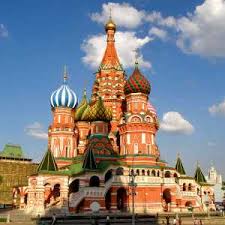
Visual arts
Early Russian painting is represented in icons and vibrant frescos, the two genres inherited from Byzantium. As Moscow rose to power, Theophanes the Greek, Dionisius and Andrei Rublev became vital names associated with a distinctly Russian art.
The Russian Academy of Arts was created in 1757 and gave Russian artists an international role and status. Ivan Argunov, Dmitry Levitzky, Vladimir Borovikovsky and other 18th-century academicians mostly focused on portrait painting. In the early 19th century, when neoclassicism and romantism flourished, mythological and Biblical themes inspired many prominent paintings, notably by Karl Briullov and Alexander Ivanov.
Russian Embroidery

The Sun Chariot, a popular motif in northern Russian embroidery.
Embroidery has for centuries played an important role in Russian daily life. The mainly linen garments were often decorated with embroidered hems, and the towels were often skillfully embellished. Embroideries were also often included in dowries, reflecting the social position of the bride’s family, but also the skills of the bride.
Most of the Russian embroidery is counted thread work, although free-style embroidery also occurs from the late medieval period in the form of the chain stitch (called tambour in Russia); it first occurred in the western parts of the country, and only became popular in the north by the late eighteenth century. Another important facet is that the cross stitch, so prominently used in western Europe, was only introduced in Russia from the west in the second half of the nineteenth century (actively promoted by the soap-manufacturer, Henri Brokar, also known as Genrich Brokar). The huge extent of Russia, stretching west from the Ural mountains, and even if we exclude Ukraine and Belarus, has given rise to a large number of regional traditions. However, a number of general trends can be discerned. Gold embroidery, among the upper classes, was very distinctive all over the country. It was applied to women’s outer clothing and headdresses. Gold embroidery was also used for religious vestments.
Apart from the gold embroidery, it is possible to distinguish two major traditions of Russian embroidery, originating in the north and the centre of Russia respectively. Embroidery styles from the north are characterised by the many figurative patterns and a limited range of colours. Russians tend to refer to this style as ‘painting’. Red, being regarded as the colour of beauty, is a very dominant colour, and the main stitches that are being used are the back stitch and the double running stitch. Embroideries are created with a red thread on a white material, or white thread on a red material. Important motifs include the Sun Chariot, and representations of horses and riders. This style is also found in Central Russia, but it is typical for the northwestern parts of the country. It is also found among the ethnic groups of the Vepsians and Karelians. Another northern tradition is darned embroidery, particularly known from Olonets district in the northwest.
The very colorful embroidery styles in Central Russia include a wide range of motifs that reflect daily life and the environment, including stylised forms of plants, birds and animals. Characteristic are the comb-like diamonds with two projections on each corner. Embroidery stitches being used include the satin stitch and the herringbone stitch. Garments and other textiles were also decorated with braids, laces, ribbons, or patterned weaving.
Festivals in Russia
- The New Year
This is one of the most important festivals in Russia, as it is celebrated respectively throughout the nation. If you are planning to visit Russia during New Years then you must be present at Red Square for the amazing fireworks that happening at night. During this time you will feel the festive mood at every inch of the place with parties, feasts and open-air festivals in various parks where you can sing and dance as you like it.
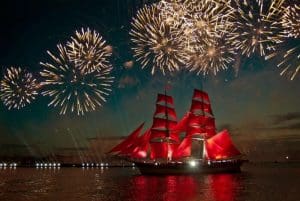
2. Orthodox Christmas
In Russia, it is not like any other country, where the end of festivals come during the new year. In fact, it is a kind of start to the upcoming Christmas festivals. In Russia, you must know that Christmas comes on January 7 and the time in between you can witness the place getting decked up with utmost beauty. Each and every bridge, park, public places decorated with beautiful lighting. So you better plan your holiday in Russia during this time has no one should miss this for the world. Although it is celebrated at a different time, the spirit of Christmas women’s very much alive within Russia. So if you are planning to visit his country during January, you can celebrate Christmas a second time after celebrating it on 25th of December.

3. Maslenitsa Festival
This festival is also called pancake festival, for the whole week, it is pancakes everywhere. Basically, this festival celebrates the farewell of winter and the dawn of spring. If you visit Russia during this time you will face carnival-like celebrations going on everywhere for an entire week. It marks the last few days consuming milk and eggs. That is why it is friendship cakes which are referred by all during the week. So if you are planning to visit then you can eat many fresh pancakes and also witness the burning session of a straw structure which they call ‘Lady Maslenitsa.

4. Reindeer Herder’s Festival
This one on the list is one of the most famous winter festivals in Russia. This is a location which you cannot witness while staying in the cities like Moscow or St Petersburg. For this, you will have to reach the remote areas of the country where Nenetes of Yamal still prefers a lot the herding of the reindeer. Basically, this is an endeavor for saving the unique occupation of herding the Reindeer. During the occasion, you can spot many races and also skiing with the help of the reindeer. It is a festival which is enjoyed by the students from outside of the country. You can also join the small activities going on to cheer up people. You will also find mouth-watering snacks which are made from the meat of Reindeer.
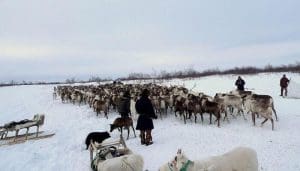
5. Russian Orthodox Easter Week
Is a festival that bears the mark of tradition in Russia. The observation of Easter according to the Russian calendar is quite different from the rest of the world. During this time the rituals related to Easter like those of Palm Sundays, are maintained devotedly by the Russians. This is the best time for deserts and if you end up being in Russia during this period you can also no taste that.

6. Moscow Golden Mask Festival
This festival includes a lot of time, almost two months when you will see many artistic activities around. This festival seems like a worship of the ancient art of drama. During this whole time in many places, you will get to see various performances all opera and ballads happening. Also when you form in drama and dance are also showcased within these performances. If your vacation to Russia is scheduled during this time then you will also be able to see the honorable award ceremonies happening on the very last day of this festival.
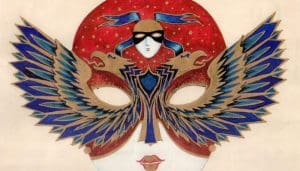
7. Victory Day
This is basically a festival which includes a lot of Patriotic sentiments while remembering the victory of Soviet Union after a tremendous fight with the Nazi power. It is also broadly celebrated by the military unit of Russia. This is the reason why you will get to see a lot of fireworks, parades by the military and many more. The whole military unit does a lot of hard work to showcase their discipline, other segments include the showcasing of many war tanks and missiles. So you will feel the emotion of patriotism while watching the Russian military marching down on the street of Red Square.
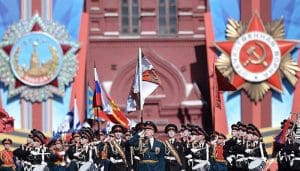
8. St Petersburg White Nights Festival
The time you will spend in St Petersburg should be between May and July because of this enriching festival which makes the vacation of every tourist a memorable one. It is quite amusing to realize that during this period of time. During this time not only that you will get to see top class Russian performers giving their best performances in various theatres. The Mariinsky Theatre deserves a special mention for their arrangements of 175 ballads and operas. Also in every corner of the performers who spend the night entertaining the passer-by. White Nights festival is actually celebrated with the purpose of making music art and dance a part of their culture.
Traditional costume of Russia
Women clothing
A sarafan is a long, trapezoidal Russian jumper dress (pinafore dress) worn by girls and women and forming part of Russian traditional folk costume.
Traditional Russian costume consists of straight, flowing lines. Beginning at the turn of the 18th century, the sarafan became the most popular article of peasant women’s clothing in the Northern and Central regions of Russia. Sarafans were regularly worn until well into the 20th century, having first been mentioned in chronicles dating back to the year 1376. The origin of the term Sarafan lies in Persia. Old Russia cultivated especially during the era of Grand Principality of Moscow strong ties to Western Asia and countries of the Middle East and served also as an intermediary in the trade between Europe and Asian countries like Persia, as well as Turkey. Sarafan most likely originated from a kaftan-like costume which were worn in Russia by woman and men.[3] Sarafans became mostly popular in the Central and Northern Russian regions. Through trade with Central Europe the quality and colour of clothes became better.
Sarafans had originally a tighter form but became wider through influence of the Russian Orthodox Church.
After the reforms of Peter the Great, which also introduced modern European cultural standards to Russia, only peasants wore the Sarafan, while the upper classes switched to Central European fashion.
In many areas of the former Grand Principality of Moscow and today’s Southern Russia also the poneva costume was worn by woman. Today the garment is most often seen at performances of Russian folk song, dance and is worn on Russian folk and religious holidays. Designers as well from Russia as from Ukraine are re-imagining the sarafan style with its old national heritage for the 21st century as summertime light dress that can actually be with its modern shape a part of today’s woman’s wardrobe.
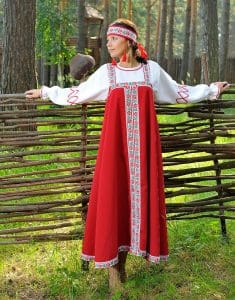

Men Clothing
Traditional Russian clothing for men featured simple cuts. The shirt worn by men had the shape of a tunic, and was made from basic canvas, folded along the weft. In the center of the piece of cloth was a hole and a small cutaway. To make the clothing bigger, tailors would add side seams and triangular wedges. In some places, tailors would also add a slit on the right or in the center.
The collar of the shirt wasn’t high, and was maximum 2 cm (0.75 in) tall. Buttons were used to close the collar.
Traditional Russian clothing not only protected against heat and cold, but also conveyed information about the person wearing it. For example, single men and young boys wore long shirts that reached above the knees. Older men and married men wore shirts that covered the knees. In some regions, young men wore shirts so long that they didn’t even need to wear pants, though this was an exception rather than the rule. Quite often, the first pair of pants was gifted to a boy after the age of 6.
Traditional pants were made of two rather thin legs, each cut of two pieces of cloth. The instep was made with diamond-shaped inserts, rather like modern gussets. As elastic did not exist, the pants were held up with a special rope, called a “gashnik”. A small pocket for combs, wallets and keys could be attached to the gashnik.
Among peasants, traditional Russian clothing was made from homemade cloth, such as hemp, cotton, or linen. In the 19th century, homemade cloths were replaced with manufactured cloths that were cheaper. Homemade cloths were only used for special clothing and rituals, such as funeral clothing.
Belts
Men always wore their shirts untucked, covering their pants. Traditional Russian dress required a belt, with the knot on the left side. It’s unsurprising that there is a saying in Russian that means “to untie oneself”, which means to act rudely or break rules.
Belts were made of cloth, knitted, or woven from threads, cords, or pieces of leather. By the beginning of the 20th century, regular leather belts had already replaced traditional belts in Russian dress. The traditional belts had been filled with meaning since pagan times, and were charms and talismans that were given at weddings or other ceremonies. After a wedding, the bride would give all the guests belts as gifts (even if this meant giving away more than 100 belts). The groom was presented with a belt, which, legend has it, had extra protective powers. Some people would weave names, prayers, or passages from holy books into belts, and children were dressed in a belt for their christening.
But the funeral clothing, also an important part of a Russian’s traditional clothes, did not include a belt. Funeral clothing included no ties, clasps, or buttons.
Wedding clothing for men was similar to standard clothing, and included a pair of pants and a shirt. The shirt had to have long sleeves. The front of the shirt, as well as the hem on the sleeves, was richly decorated with embroidery and inserts. The belt was wide and long, and was also decorated. Often, these ornaments included texts, symbols, and charms woven into the belt.


